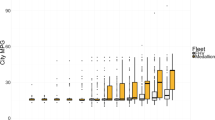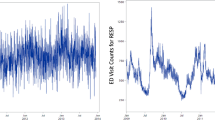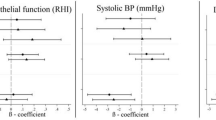Abstract
Exposure during transport and at non-residential locations is ignored in most epidemiological studies of traffic-related air pollution. We investigated the impact of separately estimating NO2 long-term outdoor exposures at home, work/school, and while commuting on the association between this marker of exposure and potential health outcomes. We used spatially and temporally resolved commuter route data and model-based NO2 estimates of a population sample in Basel, Switzerland, to assign individual NO2-exposure estimates of increasing complexity, namely (1) home outdoor concentration; (2) time-weighted home and work/school concentrations; and (3) time-weighted concentration incorporating home, work/school and commute. On the basis of their covariance structure, we estimated the expectable relative differences in the regression slopes between a quantitative health outcome and our measures of individual NO2 exposure using a standard measurement error model. The traditional use of home outdoor NO2 alone indicated a 12% (95% CI: 11–14%) underestimation of related health effects as compared with integrating both home and work/school outdoor concentrations. Mean contribution of commuting to total weekly exposure was small (3.2%; range 0.1–13.5%). Thus, ignoring commute in the total population may not significantly underestimate health effects as compared with the model combining home and work/school. For individuals commuting between Basel-City and Basel-Country, ignoring commute may produce, however, a significant attenuation bias of 4% (95% CI: 4–5%). Our results illustrate the importance of including work/school locations in assessments of long-term exposures to traffic-related air pollutants such as NO2. Information on individuals’ commuting behavior may further improve exposure estimates, especially for subjects having lengthy commutes along major transportation routes.
This is a preview of subscription content, access via your institution
Access options
Subscribe to this journal
Receive 6 print issues and online access
$259.00 per year
only $43.17 per issue
Buy this article
- Purchase on Springer Link
- Instant access to full article PDF
Prices may be subject to local taxes which are calculated during checkout



Similar content being viewed by others
References
HEI Traffic-related air pollution: A critical review of the literature on emissions, exposure, and health effects. Health Effects Institute (HEI): Boston, MA, USA. 2010, January. Report No.: HEI Special Report 17.
Perchoux C, Chaix B, Cummins S, Kestens Y . Conceptualization and measurement of environmental exposure in epidemiology: Accounting for activity space related to daily mobility. Health Place 2013; 21: 86–93.
de Nazelle A, Seto E, Donaire-Gonzalez D, Mendez M, Matamala J, Nieuwenhuijsen MJ et al. Improving estimates of air pollution exposure through ubiquitous sensing technologies. Environ Pollut 2013; 176: 92–99.
Dhondt S, Beckx C, Degraeuwe B, Lefebvre W, Kochan B, Bellemans T et al. Health impact assessment of air pollution using a dynamic exposure profile: Implications for exposure and health impact estimates. Environ Impact Assess Rev 2012; 36: 42–51.
Setton E, Marshall JD, Brauer M, Lundquist KR, Hystad P, Keller P et al. The impact of daily mobility on exposure to traffic-related air pollution and health effect estimates. J Expo Sci Environ Epidemiol 2011; 21: 42–48.
Kornartit C, Sokhi RS, Burton MA, Ravindra K . Activity pattern and personal exposure to nitrogen dioxide in indoor and outdoor microenvironments. Environ Int 2010; 36: 36–45.
Nethery E, Leckie SE, Teschke K, Brauer M . From measures to models: an evaluation of air pollution exposure assessment for epidemiological studies of pregnant women. Occup Environ Med 2008; 65: 579–586.
Physick W, Powell J, Cope M, Boast K, Lee S . Measurements of personal exposure to NO2 and modelling using ambient concentrations and activity data. Atmos Environ 2011; 45: 2095–2102.
Ragettli MS, Corradi E, Braun-Fahrländer C, Schindler C, de Nazelle A, Jerrett M et al. Commuter exposure to ultrafine particles in different urban locations, transportation modes and routes. Atmos Environ 2013; 77: 376–384.
Eeftens M, Tsai M-Y, Ampe C, Anwander B, Beelen R, Bellander T et al. Spatial variation of PM2.5, PM10, PM2.5 absorbance and PMcoarse concentrations between and within 20 European study areas and the relationship with NO2 – Results of the ESCAPE project. Atmos Environ 2012; 62: 303–317.
de Nazelle A, Fruin S, Westerdahl D, Martinez D, Ripoll A, Kubesch N et al. A travel mode comparison of commuters' exposures to air pollutants in Barcelona. Atmos Environ 2012; 59: 151–159.
Knibbs LD, Cole-Hunter T, Morawska L . A review of commuter exposure to ultrafine particles and its health effects. Atmos Environ 2011; 45: 2611–2622.
Int Panis L, de Geus B, Vandenbulcke G, Willems H, Degraeuwe B, Bleux N et al. Exposure to particulate matter in traffic: A comparison of cyclists and car passengers. Atmos Environ 2010; 44: 2263–2270.
Marshall JD, Granvold PW, Hoats AS, McKone TE, Deakin E, W Nazaroff W . Inhalation intake of ambient air pollution in California's South Coast Air Basin. Atmos Environ 2006; 40: 4381–4392.
Setton EM, Keller CP, Cloutier-Fisher D, Hystad PW . Spatial variations in estimated chronic exposure to traffic-related air pollution in working populations: A simulation. Int J Health Geograph 2008; 7: 39.
Bellander T, Wichmann J, Lind T . Individual exposure to NO2 in relation to spatial and temporal exposure indices in Stockholm, Sweden: The INDEX study. PLoS One 2012; 7: e39536.
Steinle S, Reis S, Sabel CE . Quantifying human exposure to air pollution—Moving from static monitoring to spatio-temporally resolved personal exposure assessment. Sci Total Environ 2013; 443: 184–193.
Liu L-JS, Tsai M-Y, Keidel D, Gemperli A, Ineichen A, Hazenkamp-von Arx M et al. Long-term exposure models for traffic related NO2 across geographically diverse areas over separate years. Atmos Environ 2012; 46: 460–471.
FSO ARE. Mobilität in der Schweiz, Ergebnisse des Mikrozensus Mobilität und Verkehr 2010. Neuchâtel and Berne: Federal Statistical Office (FSO), Federal Office for Spatial Development (ARE) 2012.
Ragettli MS, Tsai M-Y, Braun-Fahrländer C, de Nazelle A, Schindler C, Ineichen A et al. Simulation of population-based commuter exposure to NO2 using different air pollution models. Int J Environ Res Public Health 2014; 11: 5049–5068.
FOEN. NO2 ambient concentrations in Switzerland. Modelling results for 2005, 2010, 2015. Berne: Federal Office for the Environment (FOEN) 2011 Environmental studies no. 1123.
Zuurbier M, Hoek G, van den Hazel P, Brunekreef B . Minute ventilation of cyclists, car and bus passengers: an experimental study. Environ Health 2009; 8: 1–10.
Wacholder S . When measurement errors correlate with truth: surprising effects of nondifferential misclassification. Epidemiology 1995; 6: 157–161.
Acknowledgements
This work is part of a Europe-wide project, Transportation Air Pollution and Physical Activities (TAPAS), which is an integrated health risk assessment program on climate change and urban policies. The study is partially supported by the Swiss National Science Foundation (SNSF 324730_135673). We acknowledge the Federal Office for the Environment for supplying the fixed site measurement data and the NO2 model PolluMap. We are thankful to the Federal Statistical Office of Switzerland for providing the census data.
Author information
Authors and Affiliations
Corresponding author
Ethics declarations
Competing interests
The authors declare no conflict of interest.
Additional information
Supplementary Information accompanies the paper on the Journal of Exposure Science and Environmental Epidemiology website
Supplementary information
Rights and permissions
About this article
Cite this article
Ragettli, M., Phuleria, H., Tsai, MY. et al. The relevance of commuter and work/school exposure in an epidemiological study on traffic-related air pollution. J Expo Sci Environ Epidemiol 25, 474–481 (2015). https://doi.org/10.1038/jes.2014.83
Received:
Revised:
Accepted:
Published:
Issue Date:
DOI: https://doi.org/10.1038/jes.2014.83
Keywords
This article is cited by
-
Association of air pollution with postmenopausal breast cancer risk in UK Biobank
Breast Cancer Research (2023)
-
Long-term exposure and health risk assessment from air pollution: impact of regional scale mobility
International Journal of Health Geographics (2023)
-
Comparison of methods for assessment of children exposure to air pollution: dispersion model, ambient monitoring, and personal samplers
Air Quality, Atmosphere & Health (2022)
-
Comparison of exposure to traffic-related pollutants on different commuting routes to a primary school in Jinan, China
Environmental Science and Pollution Research (2022)
-
Location-weighted traffic-related air pollution and asthma symptoms in urban adolescents
Air Quality, Atmosphere & Health (2022)



